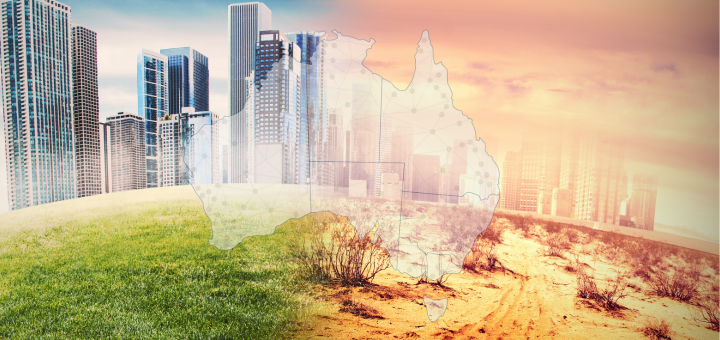Northern Australia’s communities are sending a clear message: nature is not just a backdrop to daily life, it is a fundamental driver of liveability, health and economic opportunity.
Recently, Community Views Service Lead, Dan Evans, was invited to present on the contribution that "access to the natural environment" makes to the local area liveability at the 2025 Developing Northern Australia conference. This article is adapted from Dan's slides, which have been embedded below.
How Liveable is Northern Australia?
When Northern Australians are asked what makes somewhere a good place to live, their priorities are clear: "feeling safe", access to "affordable decent housing", "high‑quality health services" and connection to the "natural environment".
Despite the importance residents place on these factors, lived experiences often fall short - both of their own expectations and the Australian average. This is reflected in an Overall Liveability Index (OLI) of 54.3 out of 100 for Northern Australia, compared to 59.5 nationally.
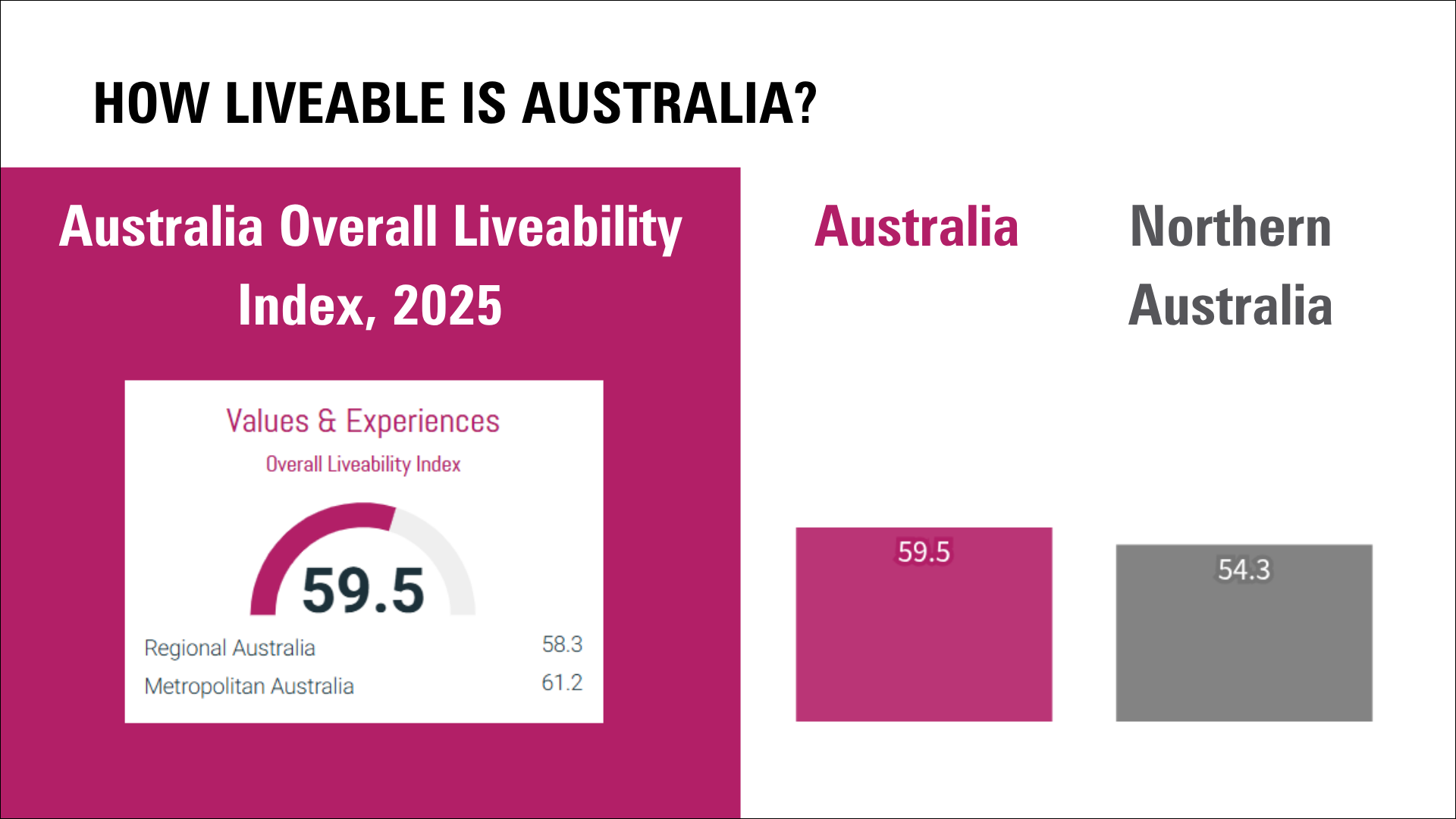
Two of the four top priorities stand out as key weaknesses: "feeling safe" (4.1 out of 10 vs 5.0 nationally) and "high quality health services" (5.0 vs 6.1). These alone account for much of the region’s lower liveability. "Affordable decent housing" also scores poorly (4.4), though this aligns closely with the national average (4.5).
By contrast, Northern Australians enjoy strong "access to the natural environment", rating it 7.5 out of 10 - almost identical to the national average of 7.6.
Other aspects of liveability, such as public transport, cultural facilities and job prospects, show mixed results. While smaller communities benefit from less congestion and a strong sense of local identity, these advantages rarely offset the practical challenges of living far from major service hubs. This tension between lifestyle benefits and essential service gaps defines the Northern Australian experience.
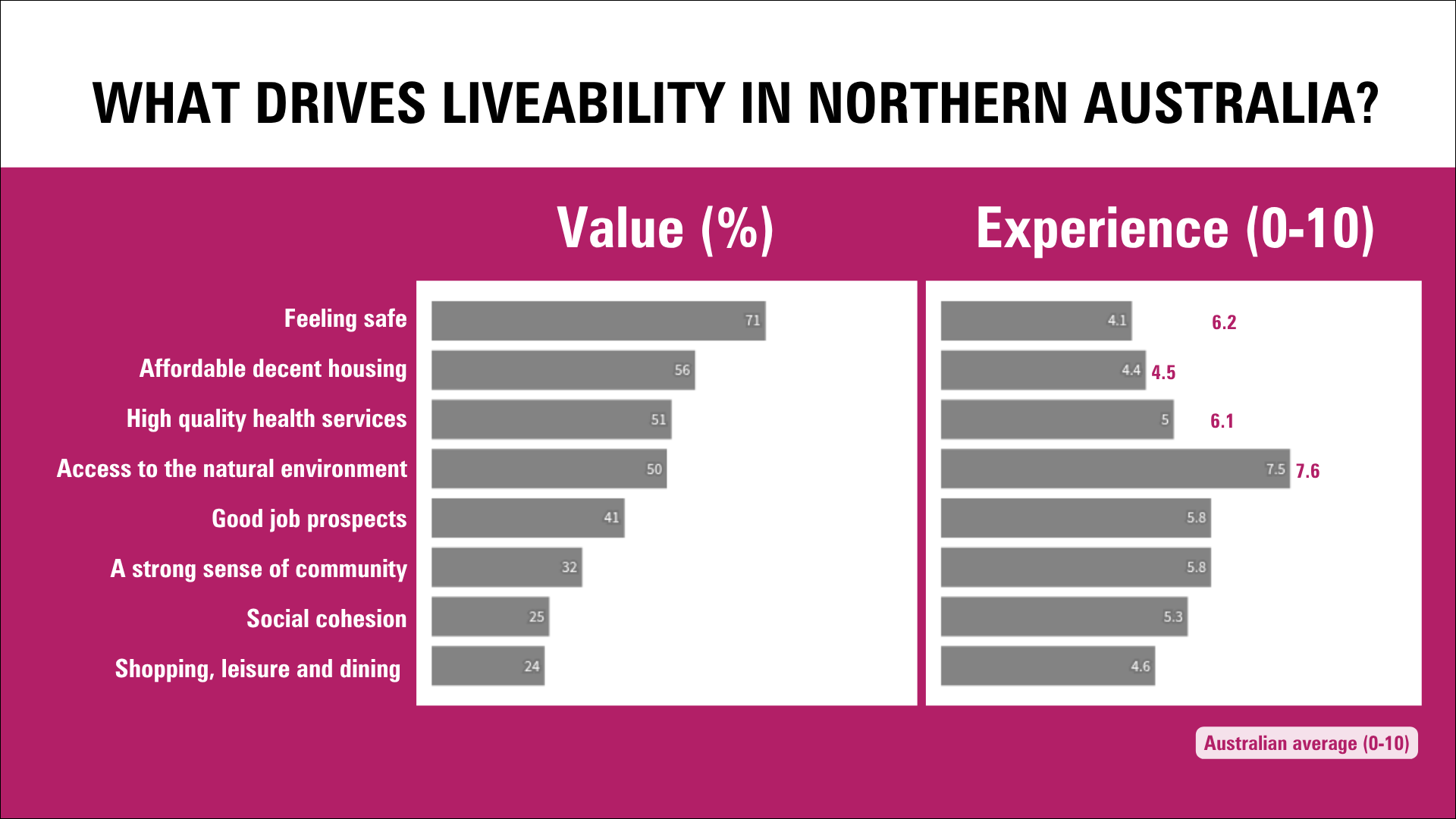
Northern Nature – Its Contribution to Community Wellbeing and Economic Prosperity
Amid these challenges, access to the natural environment stands out as a strength. Nature is not simply a backdrop to life in the north—it is a meaningful contributor to the mental health and resilience of local communities.
The average Northern Australian rates their mental health at 6.6 out of 10, consistent with the national average of 6.7. A closer look at this data reveals an important relationship between residents’ mental health and the extent to which they can access nature where they live.
Our analysis shows that Northern Australians’ mental health improves when they report strong access to the natural environment. Residents who rated their local area highly for access to nature, between 8 and 10 out of 10, also reported the best mental health, averaging 7.1 out of 10. Those who considered their access to nature to be moderate, rating it 6 or 7 out of 10, reported mental health of 6.6 out of 10. Whereas residents who felt their access to nature was poor (between just 0 and 5 out of 10) reported an average mental health score of just 6.2 out of 10.
This pattern highlights a clear connection: when Northern Australians can easily experience the natural environment around them, their wellbeing is better. By protecting and enhancing access to the landscapes that make Northern Australia unique, communities can continue to draw strength and wellbeing from the natural world around them.
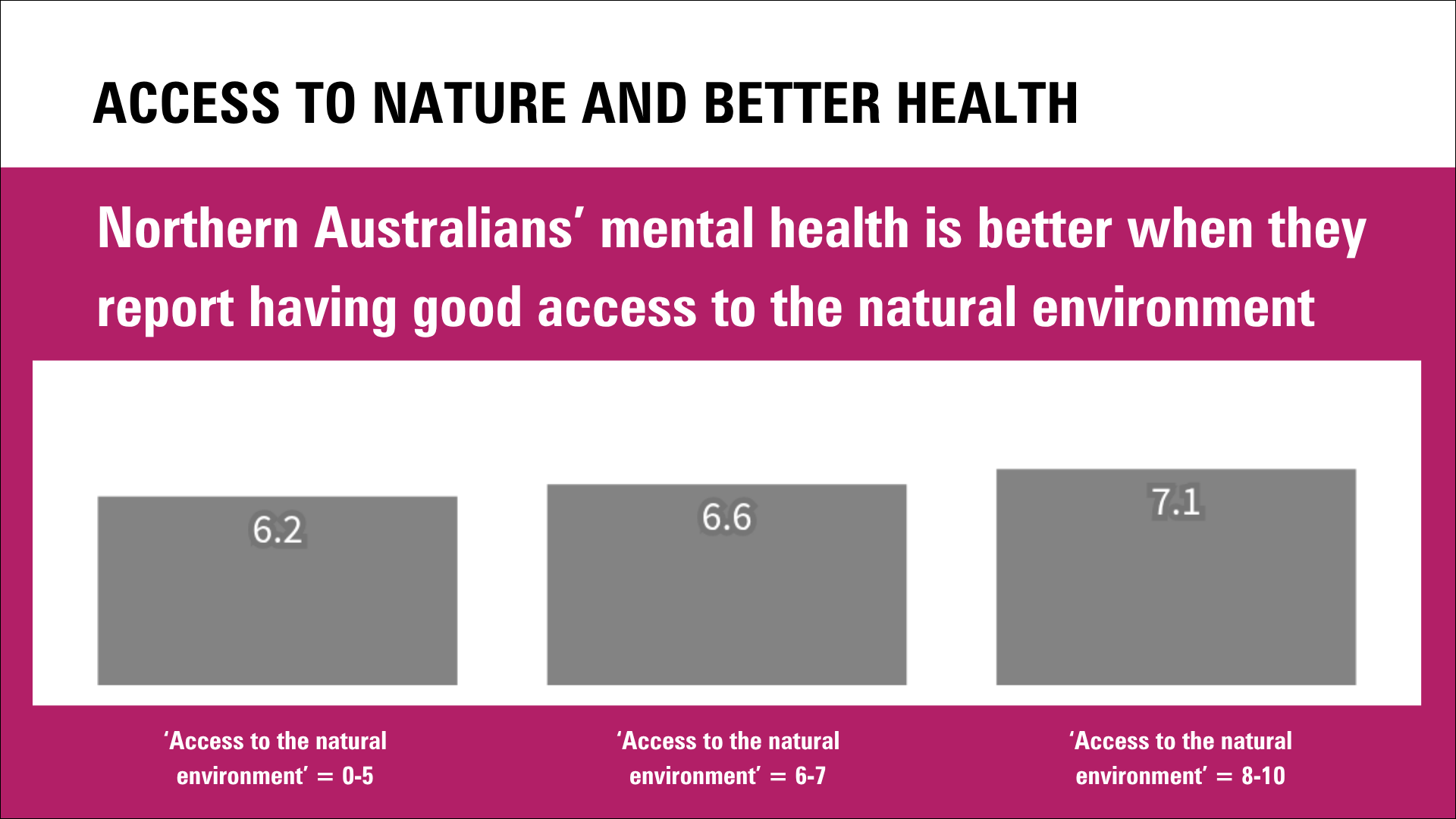
Nature also makes a strong contribution to local economies. Northern Australian communities that enjoy strong access to nature also tend to have vibrant tourism economies. The data shows that places where residents feel deeply connected to the natural environment often experience the benefits through local job creation in tourism and hospitality. Cairns is a clear example: residents rate their access to nature at 8.2 out of 10 and the local tourism sector is both significant and growing, with around 1,000 additional jobs in accommodation and food services created over the past decade. Townsville tells a similar story, with residents reporting high access to nature and the local tourism industry experiencing even greater job growth in recent years.
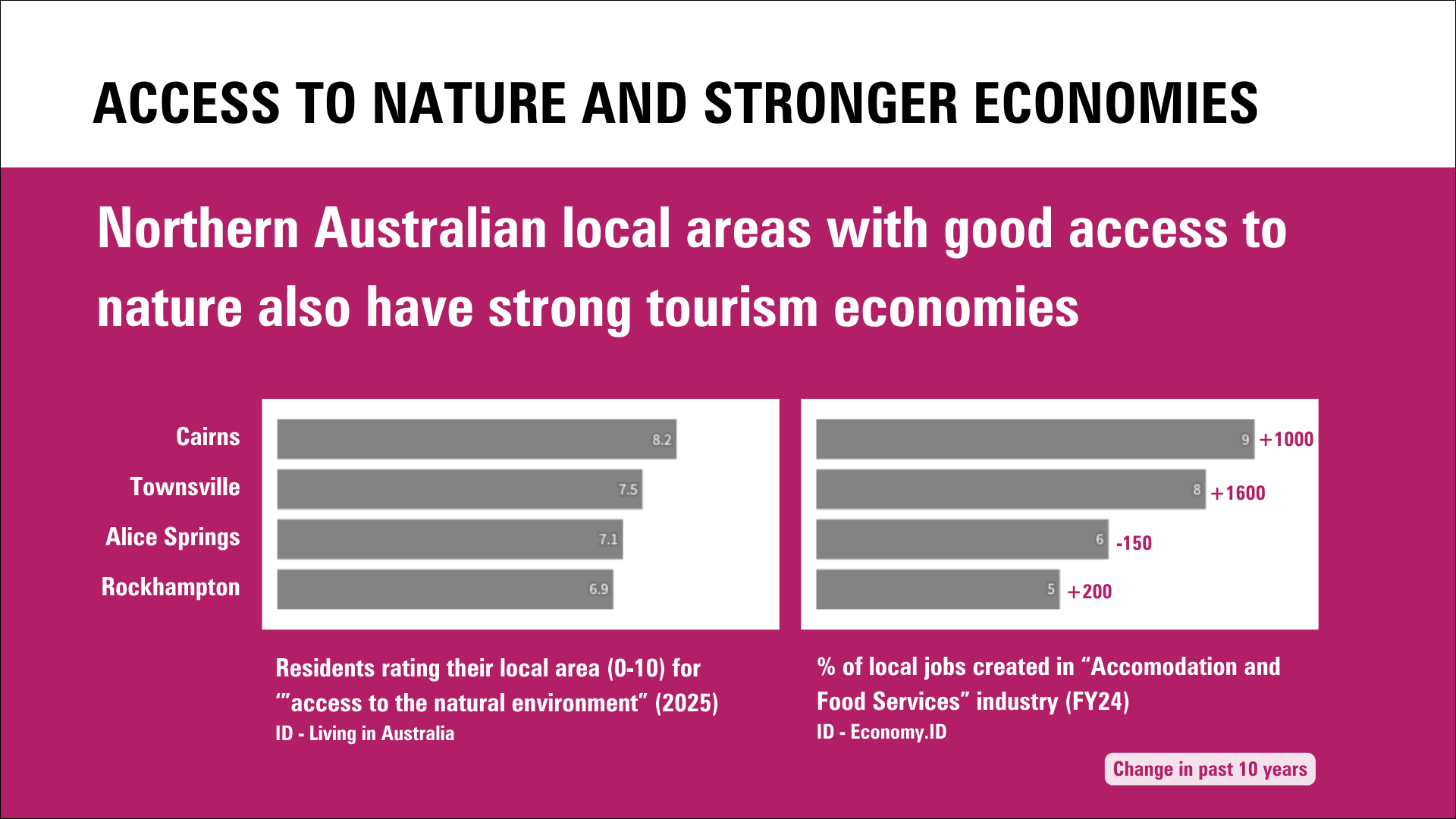
These patterns highlight the way Northern Australia’s natural assets do more than shape lifestyle—they underpin local economies, creating opportunities for communities that are closely tied to their landscapes.
Why Investing in Nature Matters
Taken together, these insights show that the benefits of nature in Northern Australia are both personal and collective. By prioritising nature, Northern Australia can create more liveable communities, be home to healthier residents and foster more prosperous economies. Three key take-aways:
- “Access to the natural environment” is the fourth most important item residents believe makes somewhere a good place to live. Any improvement in local area experiences will, by extension, enhance the Northern Australia Liveability Index. Despite this, fundamental issues regarding community safety, health equity and access to housing remain inhibitors to advancing quality of life across the North.
- Northern Australians who report good “access to the natural environment” where they live also report being in better mental health.
- Northern Australian communities with natural assets have strong and growing tourist economies.
Get in touch with Dan to discuss how insights like these can help your organisation confidently represent resident priorities in decision‑making. Explore case studies showing how our Community Views service has supported local governments, other government agencies, and the private sector to put community needs at the centre of planning.
You can also access Dan’s full presentation from the 2025 Developing Northern Australia conference.
Data informing this article is drawn from .id's annual Living in Australia survey. Living in Australia provides spatial benchmarking and context for our Community Views customers. Community Views is a survey‑based service that captures representative insights into community values, experiences and priorities, giving councils and regional partnerships nationwide a consistent, credible evidence base for planning and advocacy. By consolidating multiple engagement activities into a single annual or biennial online survey, it saves governments time and money while supporting strategies across housing, health, transport, economic development, local identity and liveability.






